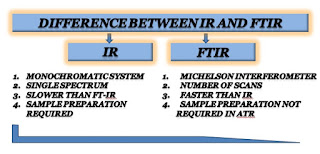Infrared spectroscopy is a significant technique in organic chemistry. It is a simple method to identify the functional groups or the structure of the analytes.
Applications of IR spectroscopy in pharmaceutical analysis:
- Identification of a functional group and structure elucidation:
The range of the group frequency is 4000-1500 cm-1 whereas the fingerprint area is 1500-400 cm-1. By using the fingerprint area in IR spectroscopy an organic compound can be identified. Each functional group absorbs a certain frequency of the radiation and shows the peaks. Hence, the position of peaks provides information regarding the functional group’s presence in the sample components or analytes.
- Studying the progress of the reaction:
Advancement of the chemical reaction can be studied by looking at the small segment of the reaction mixture from time to time.
- Identification of the structure of substances:
Infrared spectroscopy is applied to find the structure of the unknown sample compound. From the peak numbers or wave numbers provided by IR, the entire structure of the molecule can be predicted.
- Quantitative analysis:
By measuring the intensity of each analyte, Quantitative analysis of an organic mixture can be done.
- Detection of impurities:
Infrared spectroscopy is likewise valuable in the detection of the impurity in a compound by contrasting its spectrum and the spectrum of the standard sample of the compound.
Different applications of IR spectroscopy:
- Environmental analysis:
In order to overcome health and environmental concerns, FTIR spectroscopy is an important technique for analyzing the quality of water, air, and pollution levels.
- Food analysis:
Infrared fitted total reflection (ATR system) is used by the manufacturer of food products for the food analysis. This examination is necessities for compliance with food labeling requirements and maintains its quality.
- Uses for various manufacturing products:
IR spectroscopy technology is used for product development, and quality control of the paint, coatings, plastic, resins, rubbers, fillers, and adhesive manufacturer.
- Forensics applications:
These techniques can give rapid, simple and reliable analysis, hence it used by the forensic department for the evidence and identification of the substance.
You may also like this
